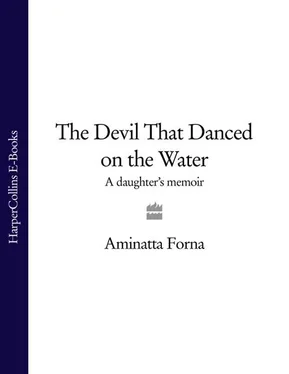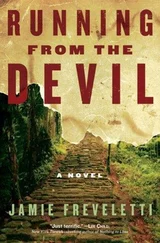A few days into his visit Pa Roke and I had lunch alone together. Everyone else was out: Sheka and Memuna at school; my father had a meal sent to him at the downtown surgery and my mother had plenty of other things to do. Before the meal my grandfather pulled out a small straw prayer mat with a picture of a mosque on it in black and red and laid it down on the ground. His mukay were left discarded on the tiled floor as he stepped onto the mat. He stood still with his hands at his side, his head bent, then he knelt, hands resting on his thighs, palms to the heavens in a gesture of supplication. It was beautiful to watch him kneeling and stretching his body out to touch the floor with his forehead with the grace of a water bird stretching its neck out across the surface of a lake.
A time would come when I would be made uncomfortable if I was caught in a room with someone who was praying, never knowing whether to go about my business and pretend I hadn’t noticed them or keep still out of reverence. My father was a Muslim, yet we had not been brought up in any particular faith. I had a Muslim name and all my relatives regarded me as a Muslim, but I had never been into a mosque or held a Koran.
It happened once that I came across Pa Roke at his midday prayers and the idea lodged in my head that I should be praying, too. So I knelt behind him, copying all his movements with no earthly idea what it all meant. Halfway through I began to feel foolish and decided to extricate myself, but that posed a new difficulty: to sidle away midway through prayers seemed sinful; at the same time I worried my grandfather might think I was making fun of him. I couldn’t make the decision, so I went on, standing, kneeling and bowing for what seemed like eternity. When he finished, he stood up, rolled his mat and walked away without looking back or acknowledging that I was there. I didn’t get the impression he was angry. Rather that he understood, better than I, the struggle that had played out in my young mind.
Pa Roke was used to eating with his hands, although sometimes he used just a spoon. Before his prayers and again afterwards he called for Big Aminatta to bring a basin of water and she held it, bracing under the weight, while he washed his hands elaborately and shook the water from his long fingers. We had a bathroom with running water, but it didn’t seem to occur to him to get up and go and use it He was just used to a different life, one in which one of the young girls in the family fetched him water from the stream every morning.
Lunch that day was groundnut stew and rice, made with plenty of hot cayenne pepper, chicken and beef stewed for hours in a stock thickened with finely ground peanuts, which Big Aminatta roasted and crushed using an empty bottle as a rolling pin. The local chickens were so tough she had to boil them up for ages with onions and tomatoes. But once cooked they were tender and full of flavour. She added small pieces of hairy, cured fish which gave off a strong, smoky taste. Groundnut stew was one of my favourite dishes.
Pa Roke worked his way through the food on his plate until there was nothing left but a small pile of chicken bones. These he picked up one by one, and devoured them methodically. First he bit off the soft tissue and cartilage. Then he slowly chewed the knuckles at either end. Finally, he cracked the fragile, splintering bone with his back teeth and licked out the dark marrow. When he had finished there was nothing, but nothing, left of the fowl to speak of. I had never seen anything like it
I was brought up to chew my bones; they were good for my teeth and the marrow full of vitamins. But I was sickened by the rubbery, slippery texture of the cartilage in my mouth and I left those pieces discarded on my plate. The grainy, soft ends of the bones I liked, but though I usually chewed them I stopped short of attacking the shaft of the bone with its sharp, jagged slivers.
I always called my grandfather Pa Roke. All my uncles, aunts and cousins did the same and even those people who were not related to us. It never occurred to me that this was not his name and I was well into adulthood when I made the discovery that Pa Roke wasn’t a name, it was a title: Pa Roke, Regent Chief of Kholifa Mamunta.
In the 1880s the chiefs of Temneland double-crossed a fearless young warrior by the name of Gbanka, whom they had hired to fight the Mende people and force open the trade routes to the Bumpe and Ribi rivers. Gbanka was born of a Mende mother and a Temne father. When he realised he had been cheated he went to his mother’s people, whom he had just defeated, and allied himself to them. There he swore a bloody revenge upon the Temne people and over the coming years he captured town after town in Temneland.
My great-grandfather Pa Morlai was a Loko and a warrior from Bombali. At the time Loko fighters were amongst the most skilled in the land. They had long-standing connections to the Mende people and an interest in the lucrative trade with the Europeans who sailed their ships far up the rivers into the interior looking for gold and ivory. When the Temnes fought back against Gbanka’s war boys, the Loko were drawn into battle on the side of the Mendes.
Pa Morlai captured and became commander in charge of the town of Mamunta, in Tonkolili, deep inside Temneland. When finally Gbanka was captured and imprisoned by the British, who soon tired when the fighting began to disrupt trading, Pa Morlai left Mamunta to return to his village. Matoko was on the other side of the Katabai Hills and when Pa Morlai entered the home of his birth he was a wealthy man, bearing the spoils of his war, including a sizeable retinue of slaves.
Among those wearing the round wooden collar of the enslaved was a young girl of twelve or thirteen called Beyas. Pa Morlai presented Beyas as a gift to his mother Ya Yalie to raise – a companion who would help her around the house and in the fields.
Beyas was the daughter of Masamunta Akaik, literally Chief Big Beard, of the Kamaras, one of the ruling families of Mamunta. As a slave with an aristocratic bloodline she was a trophy. And as she went about her tasks she impressed Ya Yalie with the delicacy of her demeanour: one day, when Beyas was about fifteen and was maturing into womanhood, the older woman went to her son and suggested that he take Beyas as one of his wives.
Beyas and Pa Morlai had four children together: three sons and one daughter. The years passed but Beyas, now called Ya Beyas by everyone in recognition of her status as a mother, never grew accustomed to her life. For all that she was married to a big man, she was still a slave.
One day, more than twenty years after Ya Beyas arrived in Matoko, a trader appeared at the marketplace selling round baskets of different sizes. They were woven out of coloured raffia and known as shuku , which people used to store clothes or pack their belongings for journeys. At the sight of him Ya Beyas became distraught and none of her children, who had accompanied her that day, could fathom what had upset her so much. Ya Beyas waved them away; refused their solicitations. She wanted to talk to the basket weaver alone. For a few minutes the two conferred, then Ya Beyas, seemingly much recovered, returned home and did not speak of the matter again. In time the incident was completely forgotten – by everyone that is, except Ya Beyas.
The weavers of Mamunta are renowned for their basketry. Ya Beyas recognised the intricate weave, the bands of turquoise and mauve that made up the design, which came from her home. Secretly she had sent a message with the trader to take to her brothers (she was certain that by now Masamunta Akaik was dead), telling them she was enslaved in Matoko. She begged them to find her and redeem her.
It took a whole year for the basket seller to complete his travels and return to Matoko. When she began to expect him back Ya Beyas invented every kind of excuse to go to the market by herself. Eventually one morning she saw the man sitting behind his huge pile of shuku and her heart lifted. But the trader had failed in his task. He had nothing to say for himself except that he had somehow forgotten.
Читать дальше












